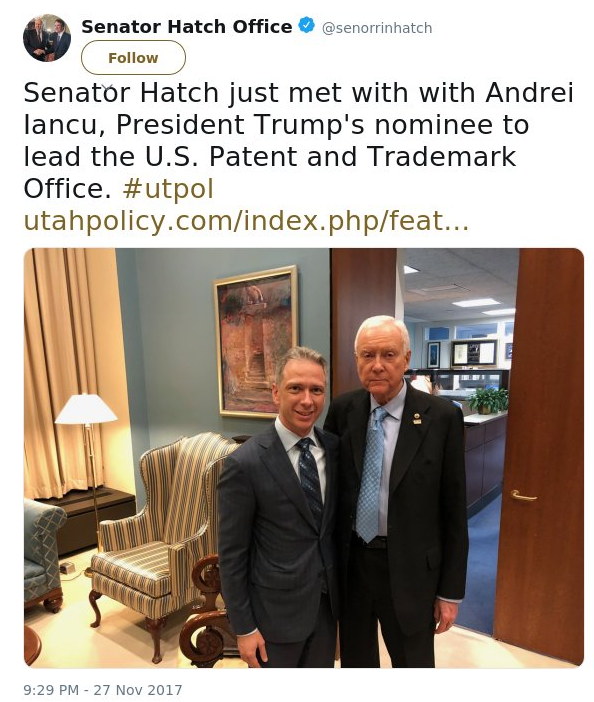Older:
Orrin Hatch, Sponsored the Most by the Pharmaceutical Industry, Tries to Make Its Patents Immune From Scrutiny (PTAB)

Summary: The U.S. Patent and Trademark Office (USPTO) seems to be serving those who pay the most to define the scope or limits of patenting; this means that even nature and life are being 'privatised' (or turned into someone's "intellectual" property)
In the wake of Mayo the USPTO is supposed to limit patents on life. SCOTUS wasn't ambiguous about it and then there's also Association for Molecular Pathology v. Myriad Genetics, Inc.
In politics in the US money buys legislation, laws, outcomes of proposed bills, and even results in elections. It also helps put 'in charge' (Congress, departments of government etc.) the 'right' people, hence the image above. Those two people seem to have 'earned' their job by
working with the 'right' companies. So here we are in 2018 and
life/nature can still be treated like an "invention". Ridiculous. Long title of the legislation (Hatch-Waxman) is: "An Act to amend the Federal Food, Drug, and Cosmetic Act to revise the procedures for new drug applications, to amend title 35, United States Code, to authorize the extension of the patents for certain regulated products, and for other purposes." As
Wikipedia points out: "The FDA has been slow to adopt regulations for the introduction of generic versions of biopharmaceutical drugs (known as "biosimilars") because the manufacturing of biopharmaceuticals is so much more complicated than small molecule drugs. Innovator companies have emphasized those complications while generic companies, insurance companies, and consumers have advocated for the FDA to finalize their process."
Notice
Patent Docs with
its latest "PTAB Life Sciences Report" by Bryan Helwig (IAM has similar reports). "Life Sciences"
is one of those terms that in general ascribe to discoveries that typically exist in nature (
already) the same attributes of actual inventions -- i.e. things which constitute new ideas.
Patent Docs earlier today advertised
"European Biotech Patent Law Webinar". Authored/posted by Pei Wu today was
this piece about patenting "biotech". Guess where it was published. Watchtroll.
"This month we highlight the possibility that the Supreme Court will consider the standard for adequacy of written description and a Federal Circuit exposition on the relationship between “blocking patents” and objective indicia of nonobviousness,"
Morrison & Foerster LLP wrote in a new article that also covers Hatch-Waxman (yes. the Hatch above). Takanori Abe (ABE & Partners) wrote about
"biosimilar patent litigation" in Japan and referring to 35 U.S.C. ۤ 102 we have a dispute over prior art; belatedly, as is usual for this blog, Mike McCandlish wrote about the
printed publication conundrum in relation to prior art or more specifically Section 102 -- a subject recently revisited by the
Federal Circuit:
The Federal Circuit held that there was an insufficient record to qualify the reference “IsoMed Constant-Flow Infusion System (“IsoMed”) as publicly accessible and therefore a printed publication under 35 U.S.C €§102(b), and remanded for additional fact finding in C.R. Bard, Inc., Bard Peripheral Vascular, Inc., v. Angiodynamics, Incorporated(Fed. Cir. Sept. 28, 2018.)
In all of these cases the prior art is sometimes nature itself. But that doesn't matter, does it? All that matters is that a lot of patents get granted, giving the illusion of innovation soaring. Under the "Life Sciences" umbrella we nowadays see lots of patents granted on genetics, i.e. the 'code' of life. Looking at Hatch's face (above), we certainly can tell how excited he is by this prospect. Enthusiastic as much as an emotionless zombie. Happy Halloween.
⬆

